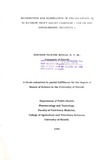Distribution and elimination of [311]-Aflatoxin h1 in rainbow trout (salmo gairdneri ) and Tilapia (oreocliromis niloticus ).
Abstract
The distribution and elimination of [3H]-AFB 1 in rainbow trout (Sulmo
gairdneri) and tilapia (Oreochromis niloticus) was studied using whole-body
autoradiography (WBA) and liquid scintillation counting. Whole-body
autoradiography is a useful method for studying the kinetics of xenobiotic
compounds within individuals of different target organs. In this method, the
compound is labelled with suitable radionuclide (14C, 3H or 35S) and
administered to each of the species studied.
Aflatoxin B1 is a potent toxin and liver carcinogen produced as a secondary
metabolite by fungi of the genus Aspergillus flavus, This compound is or
concern because it and other related mycotoxins commonly contaminate grains
and seeds used for consumption by animals and humans.
The rainbow trout (Salmo gairdneri) is exceptionally sensitive and has been
used in laboratories for studies on AFB} carcinogenesis and metabolism. Fish
models may be useful not only as environmental in situ monitors of aquatic
pollution but as alternative vertebrate species for detailed comparative studies on
mechanisms of action of carcinogens and other substances.
In this study, the distribution and elimination of aflatoxin in rainbow trout
and tilapia was. studied for 8 days after intravenous and per os administration.
The assessment was done by whole-body autoradiography and liquid
scintillation counting. Rainbow trouts were divided into two groups. The first
group was given a single intravenous dose of 1 uci/g fish body weight of 13H 1-
AFBl dissolved in ethanol. The second group of trouts were given a single oral
dose of 1 uci/g fish body weight of [3H]-AFB] dissolved in corn oil through a
stomach tube. Tilapias were also administered orally with a single dose of I
uci/g fish body weight dissolved in corn oil. Each fish was killed at designated
time interval, frozen and sectioned in a cryomicrotome. The freeze dried sections
XII
were exposed against X-ray films for 3 months and the radiolabelling was
related to the anatomical structures in the section.
The remaining blocks were used for liquid scintillation counting. Samples of
liver, cranial kidney, caudal kidney, bile, spleen, brain, abdominal fat and
muscle were collected from the frozen blocks and prepared for liquid scintillation
counting using a Packard Tri-Carb 1900 CA spectrometer. The tissues were
weighed, digested, decolourised and scintillation cocktail added before the
counting procedure.
The highest concentrations of radioactivity in rainbow trout after oral and
intravenous administration were seen in the bile, liver and caudal kidney after 1-
2 days. There was no significant difference (p> 0.(5) in radioactivity between
oral and intravenous administration in rainbow trout's liver, caudal kidney and
blood tissues. The bile showed the highest concentration of radioactivity
throughout the experimental period in tilapia. The activity in the liver and caudal
kidney of the same species was also high initially but decreased gradually to less
than 20% of the original by day 3. Low levels of radioactivity were observed in
the blood, brain, spleen, abdominal fat and muscle of the two species of fish.
There was a significant difference in radioactivity between caudal kidney
(p<0.05) and liver (p<O.Ol) of tilapia and rainbow trout respectively. However,
there was no significant difference (p>0.05) in radioactivity for blood between
the two species of fish.
The whole-body autoradiography results were similar to those of liquid
scintillation countings. Radioactivity was high in the intravenous administered
rainbow trouts than in the oral rainbow trouts and tilapia. The whole-body
autoradiograms revealed the highest concentration of radioactivity to be localised
in the liver, kidneys, bile, pyloric caeca contents and mucosa, urine,descending
intestinal contents and mucosa, uveal tract of the eye and olfactory rosette at
XlII
designated time intervals. The activity in tilapia was high in the liver, kidneys,
bile, ventricle mucosa, uveal tract of eye and small intestines.
The results of this study indicates good distribution and elimination of
aflatoxin Bj in the rainbow trout irrespective of the route of administration. High
levels were found in the bile, liver olfactory rosette, uveal tract of eye and caudal
kidney respectively in the two species of fish. The persistent high levels of
aflatoxin Bj in the bile of the two species of fish confirms bile to be the major
route of excretion. There was high significant levels of aflatoxin B1 in the liver
and caudal kidney of rainbow trout compared to tilapia following oral
administration. Fish model studies can be alternative methods for studying
kinetics of xenobiotics.
Citation
Muigai, S. N(1991). Distribution and elimination of [311]-Aflatoxin h1 in rainbow trout (salmo gairdneri ) and tilapia (oreocliromis niloticus ).Sponsorhip
University of NairobiPublisher
Department of Public Health, pharmacology and Toxicology, University of Nairobi
Description
Msc Thesis

